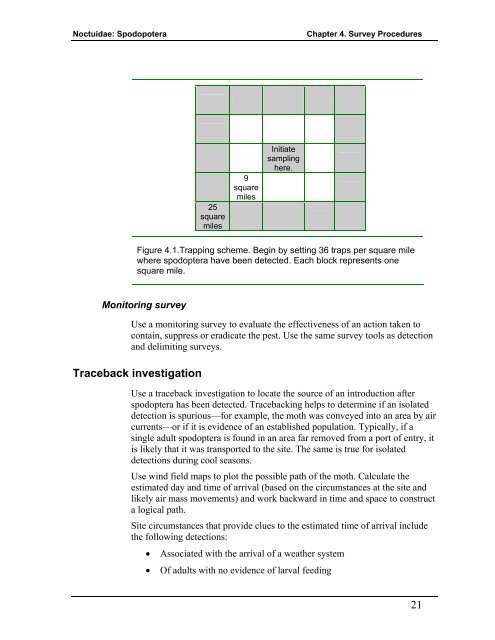New Pest Response Guidelines - Phytosanitary Resources
New Pest Response Guidelines - Phytosanitary Resources
New Pest Response Guidelines - Phytosanitary Resources
Create successful ePaper yourself
Turn your PDF publications into a flip-book with our unique Google optimized e-Paper software.
Noctuidae: Spodopotera<br />
Chapter 4. Survey Procedures<br />
25<br />
square<br />
miles<br />
9<br />
square<br />
miles<br />
Initiate<br />
sampling<br />
here.<br />
Figure 4.1.Trapping scheme. Begin by setting 36 traps per square mile<br />
where spodoptera have been detected. Each block represents one<br />
square mile.<br />
Monitoring survey<br />
Use a monitoring survey to evaluate the effectiveness of an action taken to<br />
contain, suppress or eradicate the pest. Use the same survey tools as detection<br />
and delimiting surveys.<br />
Traceback investigation<br />
Use a traceback investigation to locate the source of an introduction after<br />
spodoptera has been detected. Tracebacking helps to determine if an isolated<br />
detection is spurious—for example, the moth was conveyed into an area by air<br />
currents—or if it is evidence of an established population. Typically, if a<br />
single adult spodoptera is found in an area far removed from a port of entry, it<br />
is likely that it was transported to the site. The same is true for isolated<br />
detections during cool seasons.<br />
Use wind field maps to plot the possible path of the moth. Calculate the<br />
estimated day and time of arrival (based on the circumstances at the site and<br />
likely air mass movements) and work backward in time and space to construct<br />
a logical path.<br />
Site circumstances that provide clues to the estimated time of arrival include<br />
the following detections:<br />
• Associated with the arrival of a weather system<br />
• Of adults with no evidence of larval feeding<br />
21













